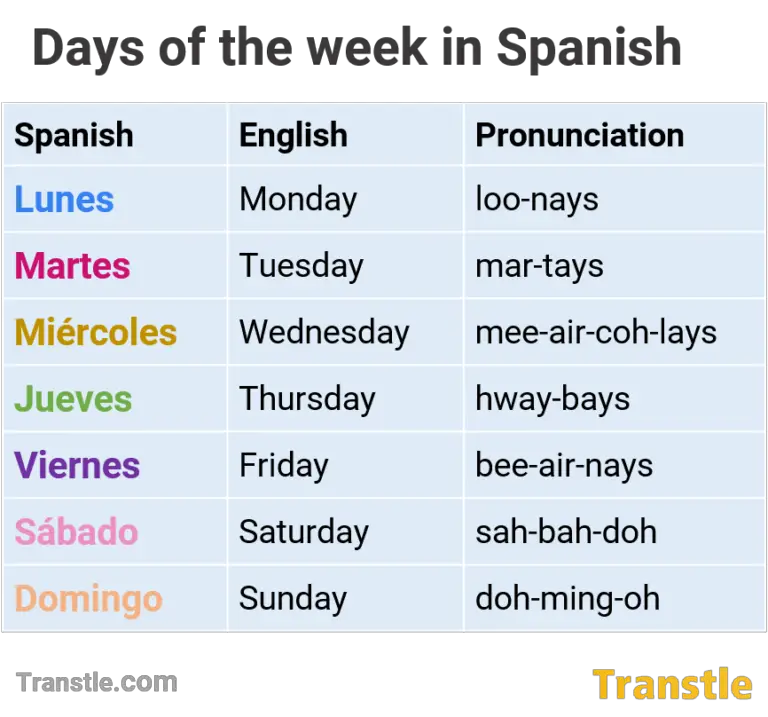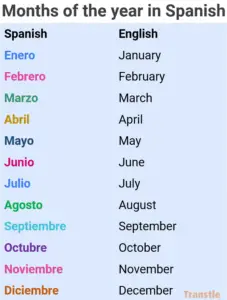Days Of The Week In Spanish with examples and pronunciation

The days of the week in Spanish
The days of the week in Spanish are basic words and are part of the vocabulary used every day. Knowing them is essential for getting by in the language. There are seven days of the week, and in English they are: lunes, martes, miércoles, jueves, viernes, sábado, domingo.
In addition to learning the vocabulary, it is important to understand the grammatical rules associated with these days, such as the correct use of articles and prepositions.
| Spanish | English | Pronunciation |
|---|---|---|
| Lunes | Monday | loo-nays |
| Martes | Tuesday | mar-tays |
| Miércoles | Wednesday | mee-air-coh-lays |
| Jueves | Thursday | hway-bays |
| Viernes | Friday | bee-air-nays |
| Sábado | Saturday | sah-bah-doh |
| Domingo | Sunday | doh-ming-oh |
Useful Related Vocabulary
To effectively discuss schedules and daily life in Spanish, these additional vocabulary terms are highly beneficial:
| Spanish | English | Gender |
|---|---|---|
| Día | Day | (m) |
| Semana | Week | (f) |
| Días de la semana | Days of the week | (m) |
| Fecha | Date | (f) |
See also: Months of the year in Spanish
Key Grammar Rules for Days of the Week
Adhering to these straightforward grammatical rules will ensure the correct usage of the days of the week in Spanish sentences:
- Always writte in lowercase: In Spanish, the days of the week are generally written using lowercase letters. Capitalization is only applied when the day is the very first word of a sentence.
|
For additional details on capitalization, you can refer to Spanish capitalization rules.
- To express the current day, simply use the phrase “Es” (meaning “it’s” or “it is”) followed directly by the day of the week.
|
- To indicate that an event occurs or will occur on a specific day, it is mandatory to use the definite article “El” before the day. Unlike English, the preposition “on” is not used in this context.
|
Common Time Expressions
Expand your linguistic capabilities for discussing time with these frequently used phrases and words:
| Spanish | English | Gender/Notes |
|---|---|---|
| Pasado mañana | The day after tomorrow | |
| Antes de ayer | The day before yesterday | |
| El día siguiente | The next day | |
| El día anterior | The last day | |
| El último día | The last day | |
| Cumpleaños | Birthday | (m) |
| Día festivo | Public holiday | |
| Mañana | Morning | |
| Mediodía | Noon | (m) |
| Tarde | Afternoon | (f) |
| Noche | Night | (f) |
| Medianoche | Midnight | (f) |
Sentences with Days of the Week in Spanish
These examples further illustrate the practical application of days of the week and related time expressions within complete sentences:
|
Quiz and exercises
The following exercises are designed to help you assess and consolidate your understanding of the vocabulary and grammatical rules discussed.
Part 1.
- What is the Spanish word for “Monday”?
- How do you write the days of the week in Spanish?
- Which article is used before the weekend days in Spanish?
- When do you capitalize the days of the week in Spanish?
- How do you say “It’s Thursday” in Spanish?
Part 2.
Translate the following sentences
- Today is Wednesday.
- What day is it tomorrow?
- My favorite day of the week is Friday.
- We have a meeting on Thursday.
- I don’t work on Saturdays and Sundays.
Answers:
- “Lunes”
- Days of the week in Spanish are written in lowercase, and they are capitalized only when they are the first word of a sentence.
- “El” is used before the weekend days in Spanish.
- The days of the week in Spanish are capitalized only when they are the first word of a sentence.
- “Es jueves.”
Translations
- Hoy es miércoles.
- ¿Qué día es mañana?
- Mi día favorito de la semana es el viernes.
- Tenemos una reunión el jueves.
- No trabajo los sábados ni los domingos.
Read next

Colors in Spanish: Complete List and Pronunciation
Colors in Spanish, complete list of colors in Spanish with pictures, sentences, and pronunciation. Learn them today!

How to Write an Essay: Step by Step Guide & Examples
Essays are very useful and practical learning and expression tools. Learn how to write the introduction, body, conclusion of an essay & how to organize it.

Months of the Year in Spanish: List & Pronunciation
The months of the year in Spanish with pronunciation, full list, grammar rules, sentences and examples. Learn them today!